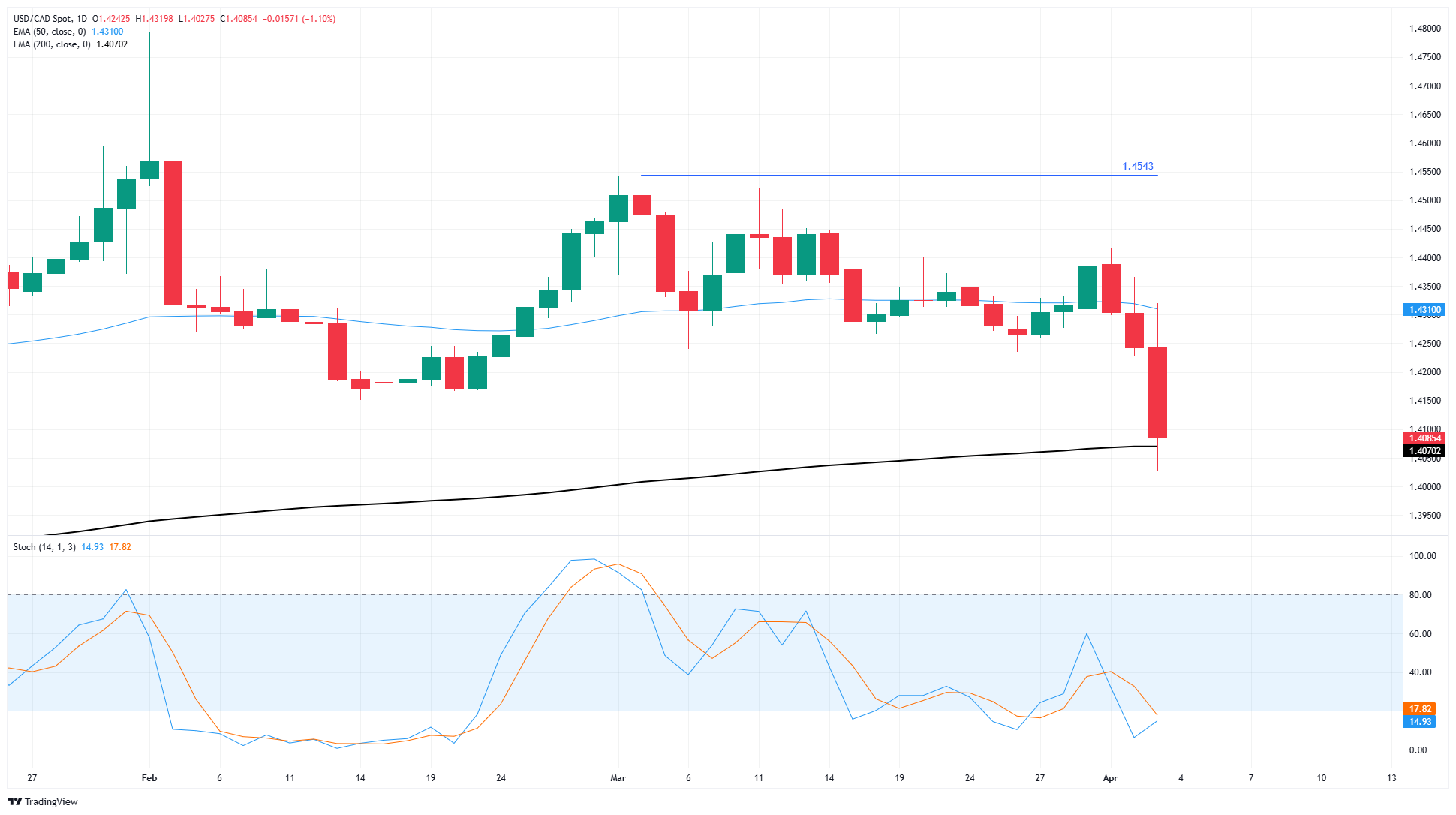Canadian Dollar rockets higher on tariff-fueled Greenback selloff
- The Canadian Dollar clipped a 17-week high on Thursday.
- The Trump administration’s tariff unveiling has spooked markets.
- The Greenback is taking a beating instead of behaving like a safe haven as it has in the past.
The Canadian Dollar (CAD) soared 1.1% against the US Dollar (USD) on Thursday, sending USD/CAD to 17-week lows near the 1.4000 handle for the first time since last December. The Loonie has been bolstered by a rapidly weakening Greenback, which is tumbling on the heels of the Trump administration’s “Liberation Day” tariff unveiling.
In normal times, the US Dollar tends to behave like a global safe haven, with investors scrambling to piling into Greenback holdings when things look unsteady. However, these are not normal times. The US Dollar is getting hammered by the Trump administration’s latest tariffs, which are set for a tiered but rapid kick-in period.
Daily digest market movers: Canadian Dollar soars on plummeting Greenback
- The Canadian Dollar gained over a full percent on Thursday, hitting multi-month highs and putting the Loonie on pace to close higher against the Greenback for a fifth straight week.
- The Trump administration is set to implement an across-the-board 10% tariff on all goods imported into the US from April 5. “Reciprocal tariffs”, which were calculated as a ratio of US imports against exports on a per-country basis, are due to begin April 9.
- Canada and Mexico have both earned a reprieve from additional tariffs, as long as they stay within the USMCA (nee NAFTA) trade restrictions. Canada has fired back with it’s own potential tariffs if US trade falls outside of its own USMCA limits.
- Federal Reserve (Fed) policymakers have been working double duty cautioning that tariffs could be bad for rate cut expectations.
- Fed's Jefferson warns Fed is not in a rush to change rates
- Fed's Cook expects inflation progress to stall after tariffs
- US Nonfarm Payrolls (NFP) figures are still due on Friday, ready to be greeted by already-exhausted markets.
Canadian Dollar price forecast
The Canadian Dollar is poised for its fifth straight weekly gain against the US Dollar. USD/CAD has backslid 3.55% peak-to-trough since the last week of February, and the pair remains down 4.73% from multi-decade peaks from late January.
The Loonie’s latest bull run has pushed USD/CAD down to the 200-day Exponential Moving Average (EMA) near 1.4070, and CAD bulls could be poised for another leg down to the 1.4000 major handle.
USD/CAD daily chart
Canadian Dollar FAQs
The key factors driving the Canadian Dollar (CAD) are the level of interest rates set by the Bank of Canada (BoC), the price of Oil, Canada’s largest export, the health of its economy, inflation and the Trade Balance, which is the difference between the value of Canada’s exports versus its imports. Other factors include market sentiment – whether investors are taking on more risky assets (risk-on) or seeking safe-havens (risk-off) – with risk-on being CAD-positive. As its largest trading partner, the health of the US economy is also a key factor influencing the Canadian Dollar.
The Bank of Canada (BoC) has a significant influence on the Canadian Dollar by setting the level of interest rates that banks can lend to one another. This influences the level of interest rates for everyone. The main goal of the BoC is to maintain inflation at 1-3% by adjusting interest rates up or down. Relatively higher interest rates tend to be positive for the CAD. The Bank of Canada can also use quantitative easing and tightening to influence credit conditions, with the former CAD-negative and the latter CAD-positive.
The price of Oil is a key factor impacting the value of the Canadian Dollar. Petroleum is Canada’s biggest export, so Oil price tends to have an immediate impact on the CAD value. Generally, if Oil price rises CAD also goes up, as aggregate demand for the currency increases. The opposite is the case if the price of Oil falls. Higher Oil prices also tend to result in a greater likelihood of a positive Trade Balance, which is also supportive of the CAD.
While inflation had always traditionally been thought of as a negative factor for a currency since it lowers the value of money, the opposite has actually been the case in modern times with the relaxation of cross-border capital controls. Higher inflation tends to lead central banks to put up interest rates which attracts more capital inflows from global investors seeking a lucrative place to keep their money. This increases demand for the local currency, which in Canada’s case is the Canadian Dollar.
Macroeconomic data releases gauge the health of the economy and can have an impact on the Canadian Dollar. Indicators such as GDP, Manufacturing and Services PMIs, employment, and consumer sentiment surveys can all influence the direction of the CAD. A strong economy is good for the Canadian Dollar. Not only does it attract more foreign investment but it may encourage the Bank of Canada to put up interest rates, leading to a stronger currency. If economic data is weak, however, the CAD is likely to fall.
